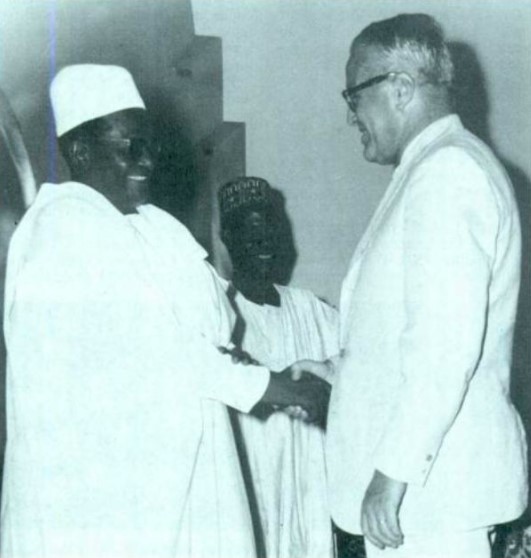|
Soudouré
Soudouré is a village in western Niger. It is located along the Niger River northwest of the capital city, Niamey. It is located in the Niamey Capital District. Soudouré is known as the birthplace of Hamani Diori Hamani Diori (6 June 1916 – 23 April 1989) was the first President of the Republic of Niger. He was appointed to that office in 1960, when Niger gained independence. Although corruption was a common feature of his administration, he gained in ..., who served as the first president of an independent Niger from 1960 to 1974. Footnotes Populated places in Niger Geography of Niamey {{Niger-geo-stub ... [...More Info...] [...Related Items...] OR: [Wikipedia] [Google] [Baidu] |
Hamani Diori
Hamani Diori (6 June 1916 – 23 April 1989) was the first President of the Republic of Niger. He was appointed to that office in 1960, when Niger gained independence. Although corruption was a common feature of his administration, he gained international respect for his role as a spokesman for African affairs and as a popular arbitrator in conflicts. His rule ended with a coup in 1974. Early life Born in Soudouré, near the capital, Niamey, Diori was the son of a public health officer in the French colonial administration. He attended William Ponty Teachers' Training College in Dakar, Senegal, and worked as a teacher in Niger from 1936 to 1938, then became a Hausa and Djerma foreign language instructor at the Institute of Study Abroad, in Paris. Independence activism In 1946, while working as the headmaster of a school in Niger’s capital city of Niamey, he became one of the founders of the Nigerien Progressive Party (PPN), a regional branch of the African Democratic Ra ... [...More Info...] [...Related Items...] OR: [Wikipedia] [Google] [Baidu] |
Niamey
Niamey () is the capital and largest city of Niger. Niamey lies on the Niger River, primarily situated on the east bank. Niamey's population was counted as 1,026,848 as of the 2012 census. As of 2017, population projections show the capital district growing at a slower rate than the country as a whole, which has the world's highest fertility rate. The city is located in a pearl millet growing region, while manufacturing industries include bricks, ceramic goods, cement, and weaving. History Niamey was probably founded in the 18th century and originated as a cluster of small villages (Gaweye, Kalley, Maourey, Zongo and Foulani Koira).Geels, Jolijn, (2006) ''Bradt Travel Guide - Niger'', pgs. 93-113 Niamey was of little importance until the French developed it as a colonial centre in the late 1890s. The town, then with an estimated population of some 1,800, was chosen as the capital of the newly created Military Territory of Niger in 1905, however, the capital was shifted to th ... [...More Info...] [...Related Items...] OR: [Wikipedia] [Google] [Baidu] |
Niger
) , official_languages = , languages_type = National languagesRépublique du Niger, "Loi n° 2001-037 du 31 décembre 2001 fixant les modalités de promotion et de développement des langues nationales." L'aménagement linguistique dans le monde (accessed 21 September 2016) , languages = , religion_ref = , religion_year = 2012 , religion = , demonym = Nigerien , capital = , coordinates ... [...More Info...] [...Related Items...] OR: [Wikipedia] [Google] [Baidu] |
Niger River
The Niger River ( ; ) is the main river of West Africa, extending about . Its drainage basin is in area. Its source is in the Guinea Highlands in south-eastern Guinea near the Sierra Leone border. It runs in a crescent shape through Mali, Niger, on the border with Benin and then through Nigeria, discharging through a massive delta, known as the Niger Delta (or the Oil Rivers), into the Gulf of Guinea in the Atlantic Ocean. The Niger is the third-longest river in Africa, exceeded by the Nile and the Congo River. Its main tributary is the Benue River. Etymology The Niger has different names in the different languages of the region: * Fula: ''Maayo Jaaliba'' * Manding: ''Jeliba'' or ''Joliba'' "great river" * Tuareg: ''Egerew n-Igerewen'' "river of rivers" * Songhay: ''Isa'' "the river" * Zarma: ''Isa Beeri'' "great river" * Hausa: ''Kwara'' *Nupe: ''Èdù'' * Yoruba: ''Ọya'' "named after the Yoruba goddess Ọya, who is believed to embody the ri ... [...More Info...] [...Related Items...] OR: [Wikipedia] [Google] [Baidu] |
Populated Places In Niger
Population typically refers to the number of people in a single area, whether it be a city or town, region, country, continent, or the world. Governments typically quantify the size of the resident population within their jurisdiction using a census, a process of collecting, analysing, compiling, and publishing data regarding a population. Perspectives of various disciplines Social sciences In sociology and population geography, population refers to a group of human beings with some predefined criterion in common, such as location, race, ethnicity, nationality, or religion. Demography is a social science which entails the statistical study of populations. Ecology In ecology, a population is a group of organisms of the same species who inhabit the same particular geographical area and are capable of interbreeding. The area of a sexual population is the area where inter-breeding is possible between any pair within the area and more probable than cross-breeding with ind ... [...More Info...] [...Related Items...] OR: [Wikipedia] [Google] [Baidu] |

.jpg)
%2C_scene_at_the_river_front.jpg)
